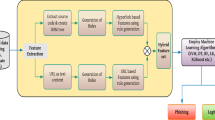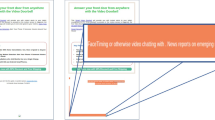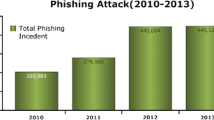Abstract
Cyberbullying is a menace in today’s socially networked world. It can have damaging physical and mental effects on the victims and hence, it needs to be tackled efficiently—several detection approaches are proposed in literature but those are mostly standalone. In this paper, we revisit the distributed and collaborative approach for detecting cyberbullying behavior using machine learning algorithms—a comprehensive enhancement of our past work—that uses many local and cloud-based collaborative configurations and different datasets. It contains a set of nodes, called detection nodes, which can identify cyberbullying employing Machine Learning classification algorithms and collaborate with each other as needed. Several experiments, consisting of various collaborative patterns, different scales, and failure scenarios, have been carried out using different Twitter\(\copyright\) datasets in this study. The empirical results obtained from the experimentation show that the proposed approach is generic (i.e., allows the incorporation of different learning and collaborative techniques), and achieves better recall and precision values when compared with the stand-alone paradigm.



Similar content being viewed by others
Availability of data and material
Not applicable.
Code availability
Not applicable.
Notes
Hatemeter: http://hatemeter.eu/.
References
Hinduja, S., Patchin, J.: Cyberbullying: neither an epidemic nor a rarity. Eur. J. Dev. Psychol. 9(5), 539–543 (2012)
Why do kids cyberbully each other? http://www.stopcyberbullying.org/why_do_kids_cyberbully_each_other.html
Šléglová, V., Cerna, A.: Cyberbullying in adolescent victims: perception and coping. Cyberpsychology 5, 2 (2011)
Learn how to control your Twitter experience. https://help.twitter.com/en/safety-and-security/control-your-twitter-experience
Basic Privacy Settings & Tools. https://www.facebook.com/help/325807937506242/
Peterson, J.: Survey: majority of cyber bullying incidents go unreported (2013). http://www.topnews.in/survey-majority-cyber-bullying-incidents-go-unreported-2375044
Mangaonkar, A., Hayrapetian, A., Raje, R.: Collaborative detection of cyberbullying behavior in Twitter data. In: IEEE International Conference on Electro/Information Technology, pp. 611–616 (2015)
Mangaonkar, A.: Collaborative detection of cyberbullying behavior in Twitter data, MS Thesis, IUPUI (2017)
CyberPatrol Parental Controls 7.7. https://www.amazon.com/CyberPatrol-CPC-1-12-N-SBXRT-Parental-Controls-7-7/dp/B001KF284U/
Email and Web Security with Data Loss Prevention (2014). https://www.watchguard.com/docs/datasheet/wg_xcs_product_matrix.pdf
Chen, Y., Zhou, Y., Zhu, S., Xu, H.: Detecting offensive language in social media to protect adolescent online safety, SOCIALCOM-PASSAT ’12, ASE/IEEE International Conference on Social Computing and 2012 ASE/IEEE International Conference on Privacy, Security, Risk and Trust, pp. 71–80 (2012)
Yin, D., Xue, Z., Hong, L., Davison, B.D., Kontostathis, A., Edwards, L.: Detection of harassment on web 2.0. Content Anal. WEB 2, 1–7 (2009)
Kasture, A.: A predictive model to detect online cyberbullying, PhD Thesis, Auckland University of Technology (2015)
WEKA (Machine Learning). https://www.cs.waikato.ac.nz/ml/weka/
Zhang, X., Tong, J., Vishwamitra, N., Whittaker, E., Mazer, J.P., Kowalski, R., Hu, H., Luo, F., Macbeth, J. Dillon, E.: Cyberbullying Detection with a Pronunciation Based Convolutional Neural Network, 15th IEEE International Conference on Machine Learning and Applications (ICMLA), pp. 740–745 (2016)
Capua M., Nardo E., Petrosino A.: Unsupervised Cyber Bullying Detection in Social Networks, 23rd International Conference on Pattern Recognition, pp. 433–437 (2016)
Agrawal, S., Awekar, A.: Deep Learning for Detecting Cyberbullying Across Multiple Social Media Platforms, European Conference on Information Retrieval, pp. 141–153 (2018)
Cornel, J.A., Christian Pablo, C., Marzan, J.A., Julius Mercado, V., Fabito, B., Rodriguez, R., Octaviano, M., Oco, N., La Cruz, A.D.: Cyberbullying Detection for Online Games Chat Logs using Deep Learning, IEEE 11th International Conference on Humanoid, Nanotechnology, Information Technology, Communication and Control, Environment, and Management, pp. 1–5
Mouheb, D., Abushamleh, M.H., Abushamleh, M.H., Aghbari, Z.A., Kamel, I.: Real-Time Detection of Cyberbullying in Arabic Twitter Streams, 10th IFIP International Conference on New Technologies, Mobility and Security, pp. 1–5 (2019)
Pawar, R., Raje, R.R.: Multilingual Cyberbullying Detection System, IEEE International Conference on Electro Information Technology, pp. 040–044 (2019)
Febriana, T., Budiarto, A.: Twitter Dataset for Hate Speech and Cyberbullying Detection in Indonesian Language, International Conference on Information Management and Technology, pp. 379–382 (2019)
Plaza-Del-Arco, F., González, M. Dolores, Ureña-López, L., Martín-Valdivia, M.: Detecting misogyny and xenophobia in Spanish tweets using language technologies, ACM Trans. Internet Technol. 20(2), 12 (2020)
Eshan, S.C., Hasan, M.S.: An application of machine learning to detect abusive Bengali text. In: 20th International Conference of Computer and Information Technology, pp. 1–6 (2017)
Menini, S., Moretti, G., Corazza, M., Cabrio, E., Tonelli, S., Villata, S.: A system to monitor cyberbullying based on message classification and social network analysis. In: Proceedings of the 3rd Workshop on Abusive Language Online (2019). https://www.aclweb.org/anthology/W19-3511
Kumari, K., Singh, J.P.: Identification of cyberbullying on multi-modal social media posts using genetic algorithm. Trans. Emerg. Telecommun. Technol. (2020). https://doi.org/10.1002/ett.3907
Zhong, H., Li, H., Cinzia, A.S., Rajtmajer, S.M., Griffin, C., Miller, D.J., Caragea, C.: Content-driven detection of cyberbullying on the Instagram social network. In: IJCAI, pp. 3952–3958. New York, USA (2016)
Zhang, Z., Robinson, D., Tepper, J.: Detecting Hate Speech on Twitter Using a Convolution-GRU Based Deep Neural Network. The Semantic Web, Springer, Berlin (2018)
Pawar, R., Yash, A., Joshi, A., Gorrepati, R., Raje, R.R.: Cyberbullying Detection System with Multiple Server Configurations, 2018 IEEE International Conference on Electro/Information Technology (EIT), pp. 0090–0095 (2018)
Tynes J.: Twitter sentiment algorithms: benchmarking precision, recall, F-measures (2014). https://www.linkedin.com/pulse/20141126005504-34768479-twitter-sentiment-algos-benchmarking-precision-recall-f-measures
Opitz, D., Maclin, R.: Popular ensemble methods: an empirical study. J. Artif. Intell. Res. (1999). https://doi.org/10.1613/jair.614
Li, R.: Dataset: UDI-TwitterCrawl-Aug2012. https://wiki.cites.illinois.edu/wiki/display/forward/Dataset-UDI- TwitterCrawl-Aug2012. Accessed 2021
Stone, M.: Cross-validatory choice and assessment of statistical predictions. J. R. Stat. Soc. Ser. B 36, 111 (1974)
Ng, A.Y., Jordan, M.: On discriminative vs. generative classifiers: a comparison of logistic regression and Naive Bayes. Adv. Neural Inf. Process. Syst. 14, 841–848 (2002)
Gamage, D.: QoS and trust prediction framework for composed distributed systems, PhD Thesis, Purdue University (2016)
5 Natural Language Processing Techniques for Extracting Information. (n.d.).: https://blog.aureusanalytics.com/blog/5-natural-language-processing-techniques-for-extracting-information. Accessed 25 Mar 2021
Everything there is to know about sentiment analysis. (n.d.): https://monkeylearn.com/sentiment-analysis/. Accessed 25 Mar 2021
Simplified text processing. (n.d.).: https://textblob.readthedocs.io/en/dev/. Accessed 4 Mar 2021
Funding
Amrita Mangaonkar was partially supported by the Dean's Scholarship provided by the IUPUI School of Science during this research.
Author information
Authors and Affiliations
Corresponding author
Ethics declarations
Conflict of interest
The authors have no conflicts of interest to declare that are relevant to the content of this article.
Additional information
Publisher's Note
Springer Nature remains neutral with regard to jurisdictional claims in published maps and institutional affiliations.
Rights and permissions
About this article
Cite this article
Mangaonkar, A., Pawar, R., Chowdhury, N.S. et al. Enhancing collaborative detection of cyberbullying behavior in Twitter data. Cluster Comput 25, 1263–1277 (2022). https://doi.org/10.1007/s10586-021-03483-1
Received:
Revised:
Accepted:
Published:
Issue Date:
DOI: https://doi.org/10.1007/s10586-021-03483-1




